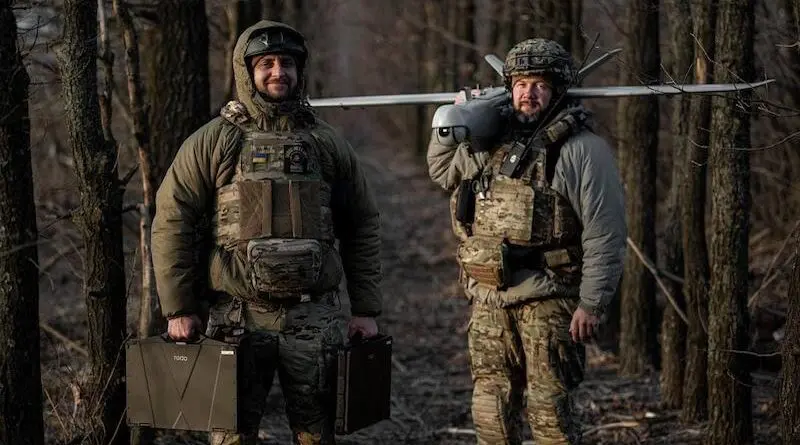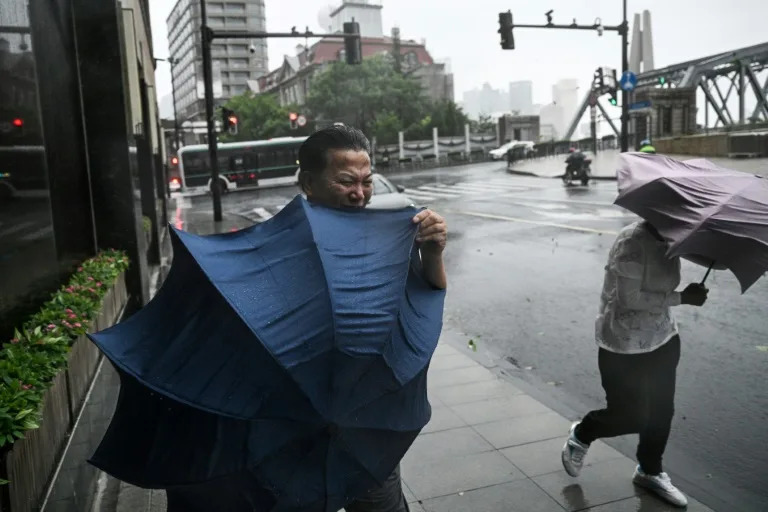From Ukraine To Myanmar, Drone Warfare Marks A Paradigm Shift – Analysis

Ukrainian soldiers pose with a drone. Photo Credit: Anton Sheveliov, Ukraine Ministry of Defence
By Antonio Graceffo
On September 10, Ukrainian forces launched the largest drone attack of the war to date, targeting Moscow with 144 drones. The assault resulted in 20 drones being shot down, while several multi-story residential buildings near Moscow were set ablaze. Flights from Russia’s most important airports were temporarily suspended. In response, Russia launched a retaliatory strike using 46 drones.
The strikes from both sides highlight a now indisputable fact: drone warfare is playing a determining role in the Ukraine war.
Armed drones, or Unmanned Aerial Vehicles (UAVs), are pilotless aircraft used to locate, monitor, and strike targets, including individuals and equipment. Since the September 11 attacks, the United States has significantly expanded its use of UAVs for global counterterrorism missions. Drones have key advantages over manned weapons. They can stay airborne for over 14 hours, compared to under four hours for manned aircraft like the F-16, allowing for continuous surveillance without risking pilot safety. Additionally, drones offer near-instant responsiveness, with missiles striking targets within seconds, unlike slower manned systems, such as the 1998 cruise missile strike on Osama bin Laden, which relied on hours-old intelligence.
There is much discussion in the US defense establishment regarding the use of drones, drone policy and how they should be incorporated into military strategy. According to the Marine Corps University, in order to calculate the effectiveness of a drone strike, several factors must be considered, including Tactical Military Effectiveness (TME), Operational Military Effectiveness (OME), and Strategic Military Effectiveness (SME). TME assesses how well the drone strike achieves its immediate objective, such as neutralizing a specific target. OME evaluates the broader impact on military operations, such as troop movements or operational coordination. Lastly, SME considers the long-term consequences of drone warfare, including the effects of drone strikes on enemy leadership, public opinion, and international relations. All three factors are critical in ensuring that drone strikes align with both short-term and long-term military objectives.
Drones are being deployed in large numbers in the Ukraine war, having already played a major role in the battles between Armenian and Azerbaijani forces in Nagorno-Karabakh. They are also becoming an increasingly key platform in the Myanmar civil war and conflicts across the Middle East. Advanced militaries, including the Pentagon, are closely monitoring these theaters to refine their own drone strategies. For example, recently the U.S. released a ‘drone hellscape strategy’ for the defense of Taiwan, while China has been conducting simulations of a drone-only attack on the island. Yet even the world’s most advanced militaries seem to lack a definitive approach to drone warfare. And, ironically, they continue to learn valuable lessons from underfunded and undertrained rebels in other far-flung global conflicts.
Drone warfare in the Myanmar civil war
The Free Burma Rangers, a frontline aid group in the Myanmar civil war, has been reporting on the increasing incidence of drone warfare in the conflict. On September 6, 2024, a Tatmadaw drone strike resulted in the deaths of four civilians—two men and two women, and one person was also wounded in the attack. Another drone dropped a handmade bomb on a civilian home in Loi Lem Lay Village, Karenni State. During the same incident, a Tatmadaw drone with six propellers experienced mechanical issues while flying over the battlefield and was subsequently captured by the Karenni Nationalities Defence Force (KNDF), a pro-democracy ethnic army. Taken together, these incidents underscore how drone warfare is still in its tactical infancy, with numerous failed deployments, and how payloads and weaponization are often being improvised by soldiers on the ground.
Other rebel armies in the Myanmar civil war, particularly the People’s Defense Forces (PDF), have developed their own drone units. For instance, a PDF unit reportedly carried out 125 drone strikes during the Battle of Loikaw in Kayah State. Another unit claims responsibility for around 80 drone strikes last year, resulting in the deaths of 80 to 100 junta troops. These forces are either manufacturing their own drones or repurposing civilian models by adding deployable explosives. The drones are inexpensive, widely available, and highly effective. Even the junta, supported by China and Russia, has adopted similar tactics by attaching mortar shells to their drones, while ethnic armiesoften use homemade explosives based on mortar shells captured from the Tatmadaw. These devices can range from 40 to 60mm, carry up to 2.5 kg of explosives and shrapnel, and are capable of killing or injuring anyone within a 100-meter radius in open terrain.
FPV drones a game-changer in the Ukraine war
In addition to homemade and modified drones, first-person view (FPV) drones can cost around $500 USD each, while reconnaissance drones equipped with advanced cameras can run into the thousands. Ukraine is deploying these drones at a rate of 100,000 per month, with plans to produce one million FPV drones in 2024. For a sense of just how important drones have become in the Ukraine war, consider the fact that this figure far exceeds the number of artillery shells supplied by the entire European Union over the past year.
FPV drones, launched from improvised platforms, can fly between 5 and 20 kilometers depending on their size, battery, and payload. Controlled by a soldier using a headset for a first-person view, with another providing guidance via maps on a tablet, these drones are often used to target vulnerable points such as tank hatches or engines. Their real-time video feed, transmitted through goggles or a headset similar to VR gaming, gives the operator precise control, especially in complex environments like urban warfare or dense terrain. FPV drones are effective for reconnaissance, targeted strikes, and even suicide missions, where they carry explosives and fly directly into a target. Unlike planes or helicopters, they are not hindered by anti-aircraft systems near the front lines. In fact, a $500 FPV drone can target the open hatch of a Russian tank worth millions of dollars, demonstrating their cost-effectiveness in modern warfare.
The rise of counter-drone and jamming technologies
As drone warfare becomes increasingly common on the battlefield, a need arises for effective drone jamming technologies. While Russian, Ukrainian, and other armies have access to jammers, ethnic armies in Myanmar lack them almost entirely. Jammers start at $2,400, but many cheap, commercially available models are essentially useless due to significant design flaws. Some have fixed antennae that point upward, despite attacks coming from the side, and many generate excessive heat without proper cooling. This raises concerns about their effectiveness in harsh environments, such as the deserts of the Middle East or the humid jungles of Myanmar.
Moreover, electronic jamming devices work on specific frequencies and drone pilots are adapting by switching to less commonly used ones. To counter this, new technologies like pocket-sized “tenchies” and backpack electronic warfare (EW) systems have emerged, jamming signals across a broader 720-1,050 MHz range, making them more effective against Russian drones. Despite Ukraine’s deployment of these newer jammers, Russia’s use of hunter-killer drone systems like the Orlan-10 for spotting and the Lancet for strikes, along with missile-equipped Orion drones, continue to challenge Ukraine’s drone defenses.
In response, Ukraine has created the Unmanned Systems Force (USF), a military branch dedicated to drone warfare. Additionally, semi-autonomous drones using AI are being developed to bypass jamming altogether. We remain in the nascent stages of drone warfare, where evolution is playing out in real time via innovations on the battlefield. In this sense, US defense spending in Ukraine is serving as an investment in research and development for the drone wars of tomorrow.
- This article was published by Geopolitical Monitor.com

Geopolitical Monitor
Geopoliticalmonitor.com is an open-source intelligence collection and forecasting service, providing research, analysis and up to date coverage on situations and events that have a substantive impact on political, military and economic affairs.







